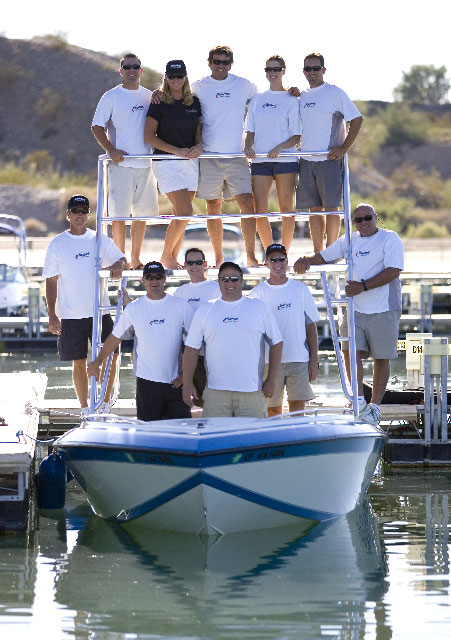Commentary: What Would (Tom) Newby Do?
What would Newby do? Well, in this photo of the Powerboat magazine crew in 2007, he’d position himself between two female staff members on the photo boat tower.
Tom Newby, the Powerboat magazine photographer who died in a helicopter accident during a shoot on Sept. 11 four years ago, had one question that everyone who ever worked with him remembers.
“What’d you do that for?”
There were two reasons you didn’t relish hearing that from Newby. First, you knew you were in for a laughing, merciless critique of something you’d done. Second, he was usually right. He was kind of a pest that way.
That’s because, despite the inherent second-guessing nature of Newby’s favorite question, he thought about things. And then he thought about them some more. Newby went to bed with a plan and woke up with a plan. From shooting a Powerboat magazine cover to making the perfect Martini—or what he believed with fanatical certainty was the perfect Martini—Newby had a plan.
More often that not, it was a really good plan.
It got to the point where we decided to have “What Would Newby Do?” (WWND) bracelets made as a practical joke. (“He thinks he’s god, anyway,” someone in our group joked at the time.) He didn’t live to see the bracelets, but Vicki Newton, his girlfriend and former Powerboat magazine publisher, had them made after he died. I wore mine until it broke about two years ago.
Come Sunday, Tom Newby will have been gone exactly four years. I saw him an hour before he died. I saw him an hour after he died. In both states, he looked great. That was the other aggravating thing about him. He always looked great.
More relevant to the high-performance powerboat world, his photos always looked great. Those photos and Newby himself inspired photographers Robert Brown, Jay Nichols and Tim Sharkey, who in no particular order are the top three shooters in the game.
“Tom Newby is my inspiration every time I pick up a camera,” says Sharkey. “He was the best of the best photographers. I hope someday to get to his level, but without a doubt he set the bar very high.”
Sharkey met Newby for the first time after the Atlantic City Poker Run during the post-run dinner. Newby had shot the run earlier in the day for Powerboat. Sharkey was a participant—he owned a Checkmate powerboat—not a photographer.
“It was my wife’s first poker run, “ says Sharkey. “When we met Tom at the dinner, he shot an image of my wife and me that we will cherish forever.”
Nichols, on the other hand, never met Newby. But that didn’t matter.
“Looking back at my early days around the performance boating world, I am sure his work influenced me in many ways I never realized,” says Nichols. “The images of these beautiful beasts in the glossy pages of boating magazines were a big part of my early attraction to the scene. Today, I view Tom’s iconic images as a measure of what is possible.”
And then there is Brown, or “RB” as everyone at Powerboat called him.
Brown and Newby worked side-by-side at many, many Powerboat magazine photo shoots. They behaved like brothers, meaning they loved each other and bickered constantly—their favorite chosen subject being politics. Put Newby in the Al Franken role and Brown in the Rush Limbaugh role and you get the idea.
Brown tried to speak at Newby’s memorial. He managed a few words but had to stop. Losing a family member, even one you dub “Mr. Perfect”—a nickname for Newby that stuck—will do that to you. But now, on the subject of working with Newby he is at no loss for words.
“The list of photography-related techniques I learned from Tom is very long,” says Brown. “Precision-marking and keeping track of rolls of film while going sideways at 80 mph in a helicopter with no doors was one of Tom’s art forms that I gladly stole from him. And when photography went digital, we were giddy at being able to look at the back of our cameras and adjust our images to something we liked.”
What didn’t Brown like about working with Newby?
“That’s easy,” he says. “When he said, ‘What’d you do that for?’ We all dreaded hearing that from him.”


